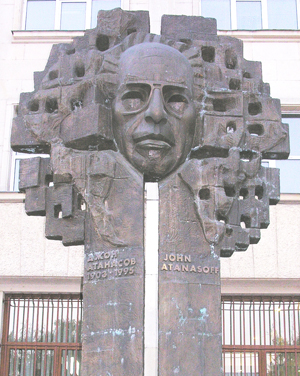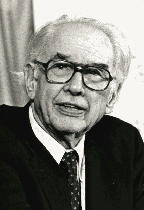JVA Biography
John Vincent Atanasoff (JVA) was born on 4 October 1903 a few miles west of Hamilton, New York. His father was a Bulgarian immigrant named Ivan Atanasov. Ivan’s name was changed to John Atanasoff by immigration officials at Ellis Island, when he arrived with an uncle in 1889.
JVA’s mother was Iva Lucena Purdy, an English teacher from upstate New York. She and John married in 1900, following John’s graduation from Colgate College with a degree in philosophy. He got a job as an industrial engineer in New Jersey and they started their family. John took electrical engineering correspondence courses at night and on weekends to further his education. After JVA’s birth in 1903, his father moved the family to Florida, accepting an electrical engineering position in a newly established town called Brewster, now an empty ghost town, but back then, the home of the phosphate mines of chemical conglomerate American Cyanamid. In Brewster, JVA completed grade school at a two room schoolhouse, and later attended middle and high school at an accelerated pace, graduating with his high school diploma at age 15.
Throughout his developmental years, JVA exhibited the characteristics of an inventive personality, and was encouraged by his mother and father to exercise his wide interests in subjects ranging from crochet and British Literature to electrical circuits and the workings of farm machinery. He developed a fascination with calculating devices when his father gave him a slide rule, with which JVA used to solve simple math problems. Amazed at the precision achieved, he experimented with more complex equations and began studying logarithms, algebra, and differential calculus. His mother helped him to understand number bases other than base-10 and he eventually learned how to make calculatations using a variety of bases, including base-2, also known as binary math. This early exposure to different methods of calculation would later inform his work on the ABC.
As the first two decades of the 1900s are often considered the “golden age of physics,” JVA’s inquiring mind did not fail to investigate the subject, and in his early high school years he decided that theoretical physics would be his life’s work. Upon his entrance at the University of Florida in 1921, JVA’s major was electrical engineering, because they did not offer a degree program in physics—electrical engineering was the most theoretical program he could find at the university. While taking these courses, he became interested in electronics and continued on to higher mathematics. He graduated from the University of Florida in 1925 with a Bachelor of Science degree in electrical engineering. He had a straight "A" academic average. Even though he had many offers of teaching fellowships, including one from Harvard, he accepted the one from Iowa State College, because it was the first one he received and because of the institution's fine reputation in engineering and sciences.
So it was, that one day in the summer of 1925 the 22-year-old boarded the train that took him to Ames, Iowa, home of Iowa State College. He was ready to make his mark in the world of science. From September to November he was busy working on his master's degree and teaching two undergraduate mathematics classes. Even though his social life was minimal due to his busy schedule, he was familiar with one campus organization, the Dixie Club, a club organized for southern students away from home. One evening, he decided to drop by the club to see what was going on. There he met Lura Meeks, a beautiful, brown-haired, blue-eyed 25-year-old home economics major from Oklahoma. This chance meeting led to another date, and then another. Soon they were best friends, seeking each other's company.
In June 1926, JVA received his master's degree in mathematics from Iowa State College, and a few days later, he married Lura. Iowa State had hired him to teach mathematics. A little over a year later, their oldest daughter Elsie, was born. When Elsie was one, the family moved to Madison, Wisconsin, where John had been accepted as a doctoral candidate. Two other children, Joanne and John, were later born to the couple.
The work on his doctoral thesis, The Dielectric Constant of Helium, gave JVA his first experience in serious computing. He spent hours on a Monroe calculator, one of the most advanced calculating machines of the time. During the hard weeks of calculations to complete his thesis JVA acquired an interest in developing a better and faster computing machine. After receiving his Ph.D. in theoretical physics from the University of Wisconsin (under John Hasbrouck Van Vleck, later a Nobel laureate), in July 1930 he returned to Iowa State College with a determination to try to create a faster, better computing machine.
In the fall of 1930 he became a member of the Iowa State College faculty as an assistant professor in mathematics and physics. During the period that he was doing experiments with vacuum tubes and radio, and examining the field of electronics, he was promoted to associate professor of both mathematics and physics and moved from Beardshear Hall to the Physics Building. JVA’s research continued to involve complex mathematical equations, for which there were no truly efficient methods for solving.
After examining many mathematical devices available at the time, Atanasoff concluded that they fell into two classes--analog and digital. Since the term "digital" was not used until much later, Atanasoff contrasted the analog devices to what he called "computing machines proper." In 1936 he engaged in his last effort to construct a small analog calculator. With Glen Murphy, then an atomic physicist at Iowa State College, he built the "Laplaciometer," a small analog calculator. It was used for analyzing the geometry of surfaces. Atanasoff regarded this machine as having the same flaws as other analog devices, where accuracy was dependent upon the performance of other parts of the machine.
The obsession with finding a solution to the computing problem built to a frenzy in the winter months of 1937. One night, frustrated after many discouraging events, he got into his car and started driving without a destination in mind. Two hundred miles later, he pulled onto a roadhouse in the state of Illinois. Here, he had a drink of bourbon and continued thinking about the creation of the machine. No longer nervous and tense, he realized that this thoughts were coming together clearly. He began generating ideas on how to build this computer, writing them down on a cocktail napkin. His four main ideas that came together that night, and were later critical for establishing he as inventor, and the ABC as the first electronic digital computer, including:
- He would use electricity and electronics for the media of the computer, which would give it speed.
- He would use base-2, or the binary number system, which would simplify its computational process.
- He would use regenerative memory, which would reduce the cost of building the machine.
- He would compute with direct logical action rather than enumeration, which would give it increased accuracy.
After receiving a grant of $650 from Iowa State College in March 1939, JVA was ready to undertake the construction of the computer. To help him accomplish his goal, he hired a particularly bright electrical engineering student, Clifford E. Berry. From 1939 until 1941 they worked at developing and improving the device, later named the Atanasoff Berry Computer (ABC). In 1942 JVA left Ames, Iowa and Iowa State on leave for a defense-related position at the Naval Ordnance Laboratory in Washington, D.C. Near the same time, Clifford Berry accepted a defense-related job in California. Although Iowa State College had hired Chicago patent lawyer Richard R. Trexler, the patenting of the ABC was never completed.
He thought he would spend a few months, or at most a few years in government, and then return to Iowa State College. Lura and their three children remained in Ames, but he made frequent trips home to see his family.
He had become Chief of the Acoustics Division at the Naval Ordnance Laboratory, a position that was paying him a salary well above the $10,000 cap on government salaries at the time. He was in charge of developing a computer for the United States Navy. At the same time, he became involved in the first atomic test in the Pacific, a project that he liked very much.
In 1948, on one of his return visits to Ames, JVA was surprised and disappointed to learn that the ABC had been removed from the Physics Building and dismantled. Neither he nor Clifford Berry had been notified that the computer was going to be destroyed. Only a few parts of the computer were saved.
The long separation from his family was beginning to take its toll. He and Lura had drifted apart. In 1949 they were divorced and Lura moved with the children to Denver, Colorado. In the same year, JVA married Alice Crosby, an Iowan who had also gone to Washington to work during the war years.
In 1949 he became chief scientist for the Army Field Forces in Fort Monroe, Virginia. After one year, he returned to Washington as director of the Navy Fuse Program at the Naval Ordnance Laboratory. He stayed in that position until late 1951. In 1952 he established The Ordnance Engineering Corporation, a research and engineering company in Rockville, Maryland, with his old friend and student, David Beecher. The company was sold to Aerojet General Corporation in 1957, and he became Manager of its Atlantic Division from 1957-1959 and Vice President from 1959-1961. In 1961 he retired.
Throughout the years following WWII, Atanasoff received several indications from individuals and industry that the builders of the ENIAC had patents on elements of computer design that originated with Atanasoff and the ABC. Two events are said to have motivated JVA’s interest and involvement in the patent issues surrounding the ENIAC. 1) Clifford Berry’s suspicous death in 1963, and; 2) The publication of R. K. Richard’s book Electronic Digital Systems in 1966 in which a serious assertion of origination was made in favor of the ABC as the first electronic digital computer. JVA spent the next several years cooperating with Honeywell Corporation in challenging the ENIAC patents, now held by Sperry Rand Corporation.
The suit Honeywell v. Sperry Rand was filed 26 May 1967 in the U.S. District Courthouse in Minneapolis, MN. The trial began 1 June 1971. The decision, handed down officially on 19 October 1973, held that “Mauchly’s basic ENIAC ideas were derived from Atanasoff, and the invention claimed in ENIAC was derived from Atanasoff.”
 Following the establishment of JVA as inventor of the first digital electronic computer, press recognition was slow to publicize the fact, partly due to the media attention focus on the Watergate Scandal, news of which was released the same day as the announcement of the court decision. Clark Mollenhoff, Des Moines Register correspondent, published the first major story about JVA as inventor, Iowa State as the site, and the details of the court case that established the ABC as the first digital electronic computer. In 1974, JVA returned to Iowa State University (the name changed to "university" in 1959) to be guest of honor and grand marshall for VEISHEA, the largest student-run celebration in the nation.
Following the establishment of JVA as inventor of the first digital electronic computer, press recognition was slow to publicize the fact, partly due to the media attention focus on the Watergate Scandal, news of which was released the same day as the announcement of the court decision. Clark Mollenhoff, Des Moines Register correspondent, published the first major story about JVA as inventor, Iowa State as the site, and the details of the court case that established the ABC as the first digital electronic computer. In 1974, JVA returned to Iowa State University (the name changed to "university" in 1959) to be guest of honor and grand marshall for VEISHEA, the largest student-run celebration in the nation.
In the late 1970s, Carl Hamilton, vice president and director of information and public affairs for ISU, encouraged the creation of a documentary on the construction of the Atanasoff-Berry Computer. The film From One John Vincent Atanasoff was completed in 1981. On 21 October 1983 (the 10th anniversary of Judge Larson's historic decision), the film was released. JVA was given a Distinguished Achievement Citation by the Iowa State University Alumni Association. Cliff Berry's widow, Jean Berry, and his mother, Grace Berry, were recognized as relatives of the co-inventor of the ABC.
After a long illness, Atanasoff died of a stroke on 15 June 1995 at his home in Maryland.
Since the landmark Honeywell v. Sperry Rand, JVA has been celebrated by many as a man who helped to change the face of the world through developments in computing. Many of the concepts that originated with the ABC are still used as basic components of the computers we use today.


